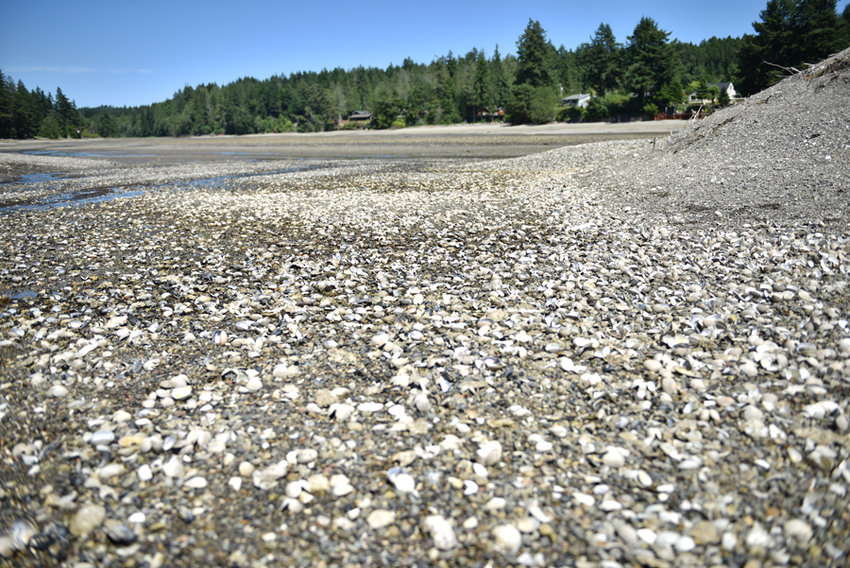 After exposure to the algae, thousands of clams surfaced and died near Rocky Bay, seen here in two views at low tide. Photo above: David Zeigler, KP News. Photo below: Chris Konieczny, KP News
After exposure to the algae, thousands of clams surfaced and died near Rocky Bay, seen here in two views at low tide. Photo above: David Zeigler, KP News. Photo below: Chris Konieczny, KP News
In mid-July Norm McLoughlin, who lives on Rocky Bay along northern Case Inlet, went to the beach to check his boat. The stench of dead clams nearly knocked him over, he said.
The beach was covered with open shells and rotting flesh. The algae spotted offshore earlier this summer had developed into a full-blown bloom, and it appeared to have taken its toll.
Teri King, a specialist with Washington Sea Grant and program manager for the SoundToxins program, a partnership with WSG, the NOAA Northwest Fisheries Science Center and Puget Sound Partners, said that a bloom started to form on June 6 in North Bay in Allyn. When King received calls about dead clams in Rocky Bay, close to North Bay, she examined water and shellfish samples sent to her from that location.
Barbara Ann Smolko, Pierce County Surface Water Management, said that similar events were reported in nearby Vaughn Bay.
The organism in both bays was Protoceratium reticulatum, a dinoflagellate phytoplankton that is one of several followed by the monitoring program. “Most of South Sound is being inundated with P. reticulatum based on the calls I have been fielding and the samples SoundToxins monitors have been viewing,” King said. “The levels are increasing from week to week, as are reported shellfish mortalities and clams surfacing.”
Based on the water sample she received July 16 from Rocky Bay, King said, “I would say the bay is in full bloom and with the cysts. I would say it could last a while.”
Kent Kingman, owner of Minterbrook Oyster Co. near Wauna, also owns approximately 75 acres of tidelands on Rocky Bay that he leases to the Taylor Shellfish Co. for cultivation of clams and oysters.
Bill Dewey, a spokesman for Taylor, said they had seen a similar problem in Discovery Bay. “We’ve experienced significant summer mortality over the years.” Last year they had unusually high mortality and he said this could be a trend, but that it is too early to judge.
Taylor will “let nature take its course” with the dead shellfish. Dewey said natural predators should clean the beach fairly quickly. Clams take about three years to mature, and Taylor has not yet decided when to reseed the beach.
“Whether or not the P. reticulatum is the cause of the mortality in Rocky Bay and other bays within Puget Sound this year and in past years is a point of active research by the SoundToxins team, which submitted a request to NOAA earlier this year to study them,” King said. “We can say that the mortalities and P. reticulatum are co-occurring and warrant an active investigation.”
P. reticulatum is found in all oceans and can produce yessotoxins, which can be toxic for clams and oysters. Yessotoxins are regulated in the European Union based on concerns for human health, though the degree of harm to humans is unclear.
UNDERWRITTEN BY THE FUND FOR NONPROFIT NEWS (NEWSMATCH) AT THE MIAMI FOUNDATION, THE ANGEL GUILD, ADVERTISERS, DONORS AND PEOPLE WHO SUPPORT INDEPENDENT, NONPROFIT LOCAL NEWS